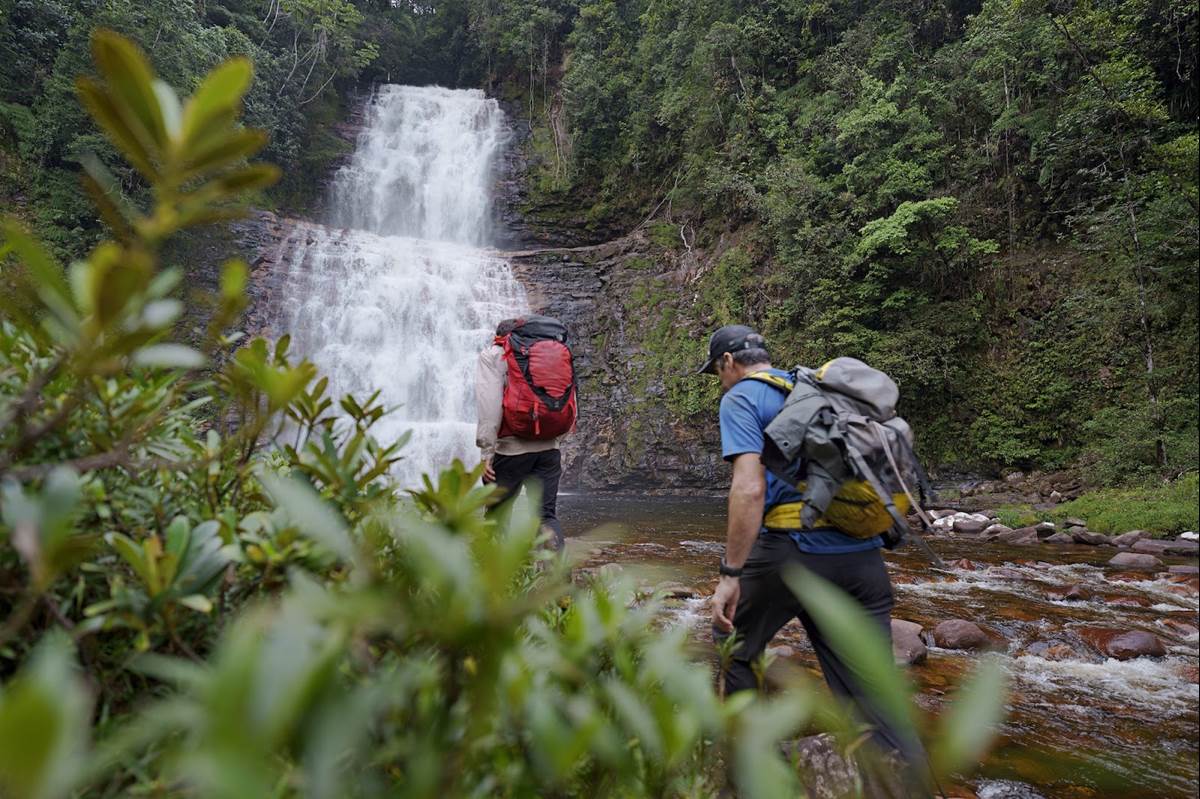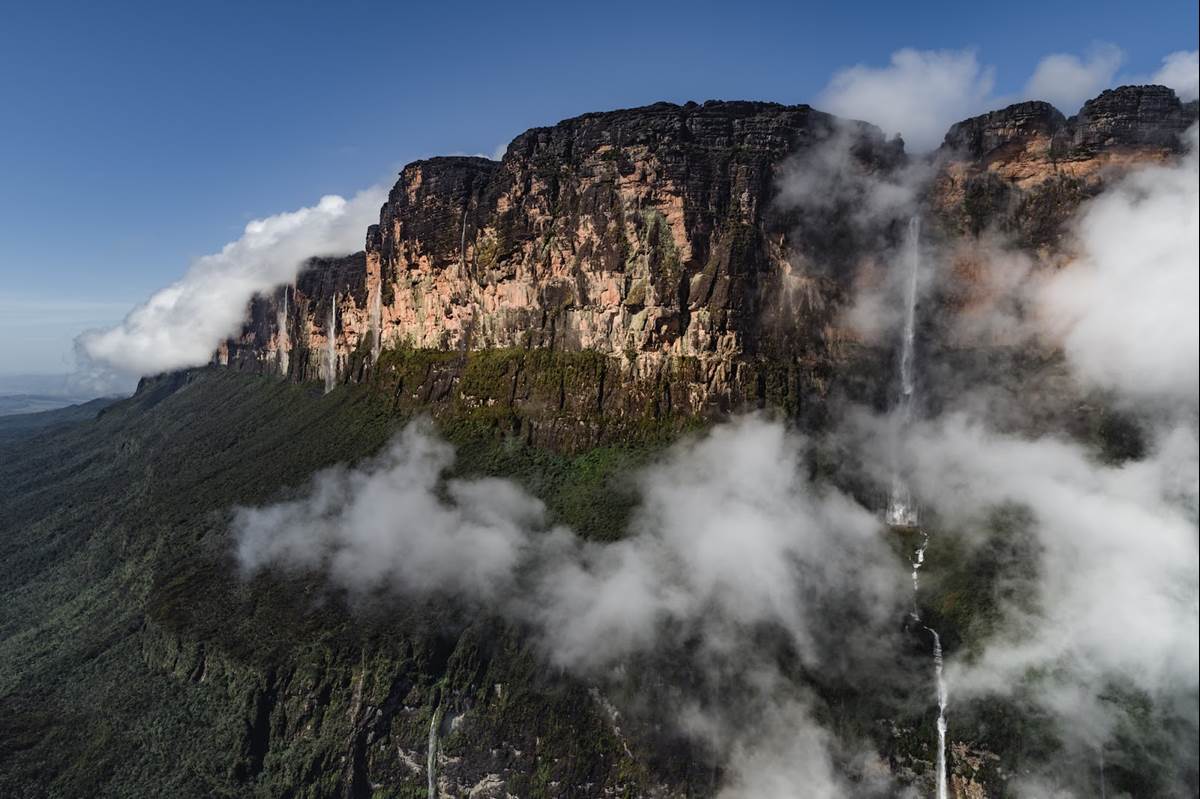Mark Synott is a New York Times bestselling author, pioneering big wall climber, and National Geographic Explorer who served as the expedition leader on a trip to Guyana to help biologist Dr. Bruce Means study an unexplored tepui. The trip is documented in Explorer: The Last Tepui premiering this Earth Day on Disney+ and in advance of the premiere, we had the chance to chat with Mark about his climbing career, his collaboration with Dr. Bruce Means, and his emotional connection to this expedition.
Laughing Place:
How did you get involved with this expedition to Guyana to climb an unexplored tepui?
Mark Synnott:
It was 20 years ago and I was on this climbing quest, like so many of us are. I was a professional climber and I just was obsessed with climbing, and particularly with going to remote places and doing first descents on big cliffs. I think climbing is naturally a contemplative kind of thing because you're in these beautiful places, you're sitting on mountains, you're looking out. You're thinking about things and philosophizing. I've always been like that. I remember just looking out and just thinking, "Gosh. This is amazing. But who is getting anything out of it other than me?" I was like, "There's not that many people." Ultimately, as awesome as this is, it is kind of a selfish pursuit, and I didn't like that idea. I didn't mind it so much, but I just thought to myself, "Well, I don't know if I want to hang my hat there for my whole life."
Another thing that I figured out from sitting on mountains and thinking about life was that the most valuable commodity that I possessed was time, and how I spent my time was going to define who I was as a human being, and I didn't want to spend all of my time on selfish pursuits. So I started thinking about how I didn't want to reinvent myself, but I wondered, "Is there a way to use the skills that I have as a climber to do something more meaningful than just doing a first descent." In a roundabout way, that's how I met [Dr. Bruce Means], because I went to National Geographic. I basically posed that idea, and I specifically was interested in Tepuis. I knew that National Geographic had covered Tepuis in the past. I'd read an amazing article in the magazine that came out in 1989. I thought, "This could be the place." Because they do science there and it's super rugged, crazy terrain, and this is an example of just awesome serendipity.
I floated that out to someone that I knew at National Geographic, and they said, "You know what? That's so weird that you bring that up, because we have this scientist who wants to get a grant and wants to go to the Tepuis, is specifically looking for a rigor ropes person guide."
That's how I first connected with Dr. Bruce Means. We went on our first trip together in 2003, and this most recent expedition that we did was our fifth trip together. That's how it came about. I really and truly feel like meeting Bruce was just one of those… I guess it would mark what you might call an inflection point in my life. That I was looking for something more, and then I developed this symbiotic thing with Bruce. And there you go. Then we just kept going and we hit it off.
Under all that, I still just want to climb and go on adventures. You know? This trip was so cool because we did both, and it was climbing with a purpose and it was what I was always looking for and it was the thing that was missing a bit in the early years. I feel like it's broadened my horizons greatly as a climber, as an explorer and adventure.
Laughing Place:
Were you concerned that the goal of this expedition might not be achievable and you might come home without a story to tell or a discovery to share? Did you have any misgivings about Dr. Bruce Means’ age?
Mark Synnott:
Yes. Every time. One of these days, that will happen, and the wheels will come off the bus. I don't know. Maybe I have enough goodwill in the bank that I can just eat one like that. I never really worried that much about that. It's like if you're going to do ambitious things, you have to take a lot of risk. You have to take personal career risk, but also risking your livelihood and your wellbeing. So yes, that's there. It's always there. It's been there on every project, practically, that I've ever done. And it's very much there with this next thing that I have in the works right now. But more than that, what I was really worried about, the thing that kept me up at night, was what if something happened to Bruce? What if Bruce got hurt? What if Bruce died out there? What if we pushed him too hard? What if he had an accident? That weighed really heavily when we were on the trip. I thought about it a lot beforehand, and then I thought about it constantly when we were out there.
I don't know if that really comes through in the [National Geographic] article and in the film as strongly as I felt it, but I was really concerned about his well-being. That's a big part of why he didn't go up the cliff with us, because I personally got to a certain point where I just felt like, "Okay, I don't think I can actually get him to the base of the cliff safely, and I don't feel that good about bringing him up the wall with us. It's too dangerous."

Climbers Alex Honnold and Mark Synnott trekked through the Amazon jungle for days to make a first ascent up the tepui face of Mount Weiassipu in Western Guyana. (National Geographic/Renan Ozturk)
Laughing Place:
You obviously care very much about Bruce. How were you emotionally affected by being present for the culmination of his life’s work?
Mark Synnott:
It's weird, but what you're talking about, I've been feeding off that for 20 years now. That's why I say I just feel so lucky that I've met this guy. He single-handedly changed my personal trajectory. Part of the reason why I'm doing these cool stories for National Geographic is because I met Bruce and because he opened my eyes to this whole new world. The reason why that happened is because his passion and enthusiasm and motivation is contagious. It's like magic, and you can see it in the film. But imagine what it's like in real life. It blew me away when we did our first trip together in 2003.
This trip is the culmination of all of that. It's a 20 year journey. His journey with the Tepuis is much deeper than that. I came in 20 years ago, and this was the ultimate trip. Kind of like a Magnum Opus for Bruce that we were always dreaming about. There's that, there's being on the trip, there's feeding off of him, and then there's the film, incredible, and then the story for the magazine where I got to put all that in my own words, and I always wanted to profile Bruce. I wanted the world to know about him, and so I feel some pride in that.
Laughing Place:
This is a centerpiece of Disney+'s Earth Day celebration, and you talked about how this is more than just climbing. This is about the nature involved that climbers can experience. What do you hope viewers will get from the experience?
Mark Synnott:
We'd like to draw attention to the Upper Paikwa River Basin and specifically so the government of Guyana might consider conserving it and protecting it so that it's not going to be destroyed by gold and diamond mining and logging. So that's one thing. But I would also like people to appreciate biodiversity the way that Bruce does and why it's so important.
Bruce continuously talks about how we've only discovered 10% of the species in the world. So 90% of the species are still undiscovered. Of that 90%, species are going extinct every day, and they're ones that we didn't even know existed. This ecological web that human beings aren't part of is being picked apart. If we pull too many strands out of it, the whole thing is going to collapse. A lot of people understand that. That's what Earth Day is all about. That's what our trip was all about. Protecting the ecological web. I think a lot of people are already tuned into that, but some aren't. The more that people know about it, the more they're going to care about it, and the more we care about things, the better we're going to be at protecting it.
You can check out National Geographic Explorer: The Last Tepui on Disney+ this Earth Day.

